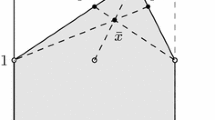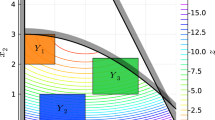Abstract
Logical relations occur frequently in integer programming problems and are modelled by introducing binary variables in association with linear expressions. Applications requiring constraints involving precedence, exclusion, implication and other conditions give rise to the logical relations OR and IMPLIES in the models. These relations will be considered in this paper from a modelling point of view and formulations investigated for situations where the logical variables link sets of integer variables. Valid inequalities (cuts) that can be added to a model will be developed for a number of the formulations and the computational benefits of these cuts will be considered from an experimental point of view by considering the performance of sets of problem instances. New formulations and combinations of older established formulations will be considered. It will be contended that tight formulations may not always be the most successful.
Similar content being viewed by others
References
Balas, E. (1979). Disjunctive programming. Annals of Discrete Mathematics, 5, 3–51.
Balas, E. (1998). Disjunctive programming: properties of the convex hull of feasible points. Discrete Applied Mathematics, 89, 3–44.
Balas, E. (2005). Projection, lifting and extended formulation in integer and combinatorial optimization. Annals of Operations Research, 140, 125–161.
Balas, E., & Perregaard, M. (2003). A precise correspondence between lift-and-project cuts, simple disjunctive cuts, and mixed integer gomory cuts for 0–1 programming. Mathematical Programming B, 94, 221–246.
Balas, E., Bockmayr, A., Pisaruk, N., & Wolsey, L. (2004). On unions and dominants of polytopes. Mathematical Programming A, 99, 223–240.
Barth, P. (1995). Logic-based 0–1 constraint programming. Boston: Kluwer Academic.
Beaumont, N. (1990). An algorithm for disjunctive programs. European Journal of Operational Research, 48, 362–371.
Bockmayr, A., & Kasper, T. (1998). Branch and infer: a unifying framework for integer and finite domain constraint programming. INFORMS Journal on Computing, 10, 287–300.
Chua, T.-J., Liu, M.-W., Wang, F.-Y., Yan, W.-J., & Cai, T.-X. (2007). An intelligent multi-constraint finite capacity-based lot release system for semiconductor backend assembly environment. Robotics and Computer-Integrated Manufacturing, 2, 326–338.
Cornuejols, G., & Dawande, M. (1999). A class of small hard 0–1 programs. INFORMS Journal on Computing, 11, 205–210.
Guignard, M., Johnson, E., & Spielberg, K. (2005). Logical processing for integer programming. Annals of Operations Research, 140, 263–304.
Hooker, J. N., & Osorio, M. A. (1999). Mixed logical-linear programming. Discrete Applied Mathematics, 96–97, 395–442.
Jeroslow, R. (1989). Representability in mixed integer programming. Discrete Applied Mathematics, 17, 223–243.
Jeroslow, R. G., & Lowe, J. K. (1985a). Modeling with integer variables. Mathematical Programming Studies, 22, 167–184.
Jeroslow, R. G., & Lowe, J. K. (1985b). Experimental results on the new techniques for integer programming formulations. Journal of the Operational Research Society, 36, 393–403.
Kallrath, J., & Wilson, J. M. (1997). Business optimisation using mathematical programming. London: Macmillan.
McKinnon, K. I. M., & Williams, H. P. (1989). Constructing integer programming models by the predicate calculus. Annals of Operations Research, 21, 227–246.
Mitra, G., Lucas, C., Moody, S., & Hadjiconstantinou, E. (1994). Tools for reformulating logical forms into zero-one mixed integer programs (MIPS). European Journal of Operational Research, 72, 262–276.
Raman, R., & Grossman, I. E. (1994). Modeling and computational techniques for logic based integer programming. Computers and Chemical Engineering, 17, 563–578.
Sellmann, M., Zervoudakis, K., Stamatopoulos, P., & Fahle, T. (2002). Crew assignment via constraint programming: integrating column generation and heuristic tree search. Annals of Operations Research, 115, 207–225.
Volgenant, A., & de Waal, A. A. (2006). A heuristic for multiple-feeder PCB manufacturing. Journal of the Operational Research Society, 57, 1134–1141.
Williams, H. P. (1999). Model building in mathematical programming (4 ed.) Chichester: Wiley.
Williams, H. P., & Brailsford, S. C. (1997). The splitting of variables and constraints in the formulation of integer programming. European Journal of Operational Research, 100, 623–628.
Yan, H., & Hooker, J. N. (1999). Tight representation of logical constraints as cardinality rules. Mathematical Programming, 85, 363–378.
Yan, H., Yu, Z., & Cheng, T. C. E. (2003). A strategic model for supply chain design with logical constraints: formulation and solution. Computers and Operations Research, 30, 2135–2155.
Author information
Authors and Affiliations
Corresponding author
Rights and permissions
About this article
Cite this article
Foulds, L.R., Toklu, B. & Wilson, J.M. Modelling either-or relations in integer programming. Ann Oper Res 166, 203–222 (2009). https://doi.org/10.1007/s10479-008-0409-z
Published:
Issue Date:
DOI: https://doi.org/10.1007/s10479-008-0409-z




